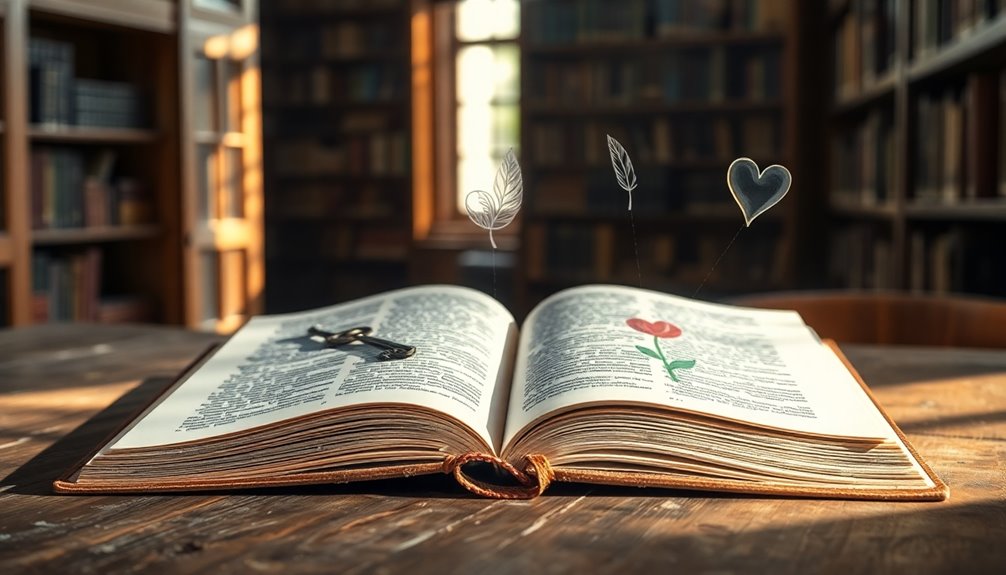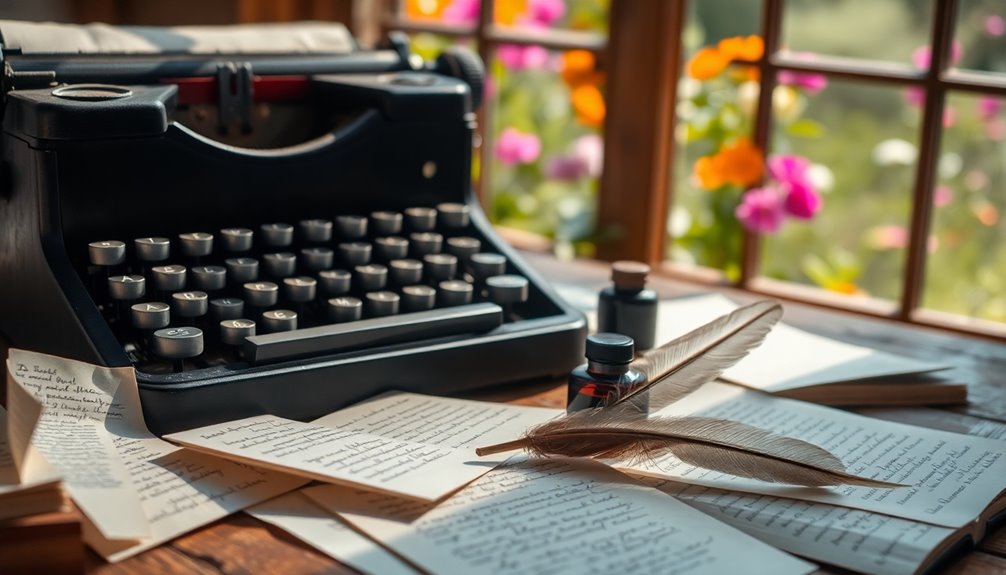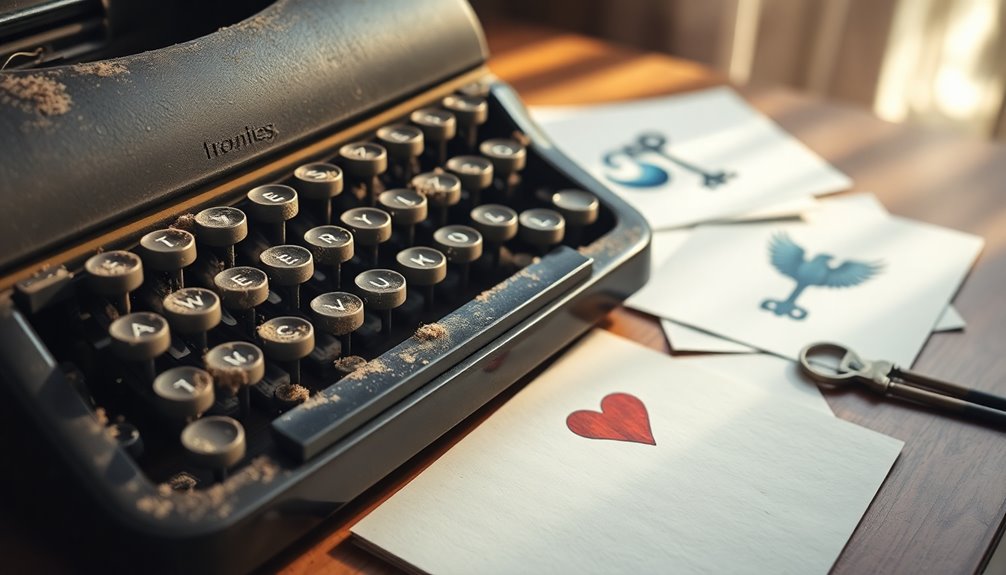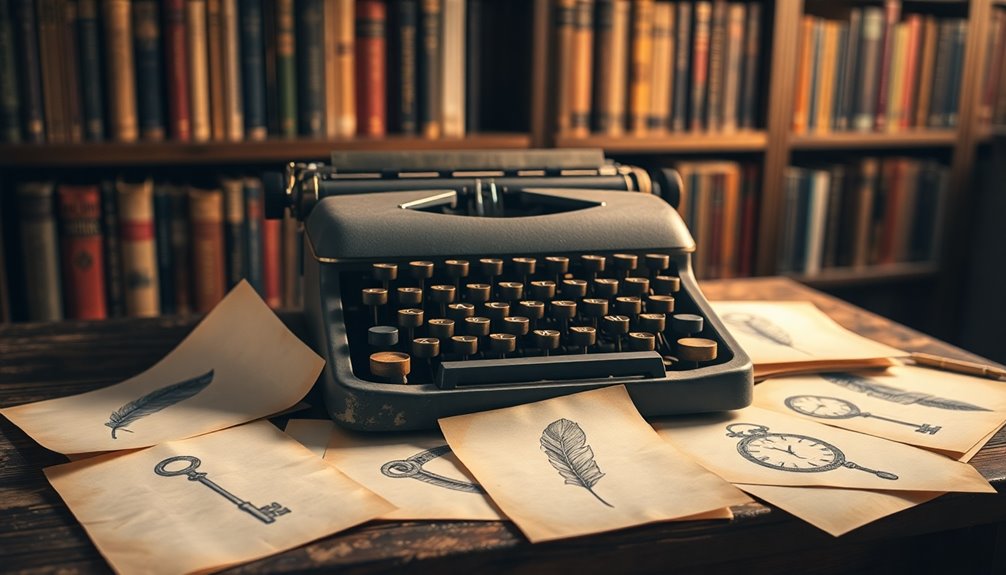Authors use symbolism to make their stories more exciting and meaningful. They turn simple objects, characters, and events into symbols that express deeper themes and emotions. For example, a heart might represent love, while a weathered tree can symbolize strength. By using symbols, authors help you connect with the story on a personal level. You might notice certain symbols repeating, hinting at bigger ideas and making you think! It's like a treasure hunt for meaning! So, keep an eye out for these special symbols, and you'll discover even more surprises hidden in the text.
Key Takeaways
- Authors convey deeper meanings by using symbols to represent complex themes and emotions, enhancing narrative depth and reader engagement.
- Symbolism can foreshadow events and create patterns, allowing readers to identify significant developments within the story.
- Writers utilize various types of symbolism, such as universal and contextual, to connect with diverse audiences and evoke personal interpretations.
- Effective symbolism relies on concrete imagery and sensory details, making symbols relatable and impactful within the narrative's context.
- Authors evolve symbols throughout the story, enriching their meanings as characters encounter challenges and reinforcing themes at key moments.
Definition of Symbolism

Symbolism, at its core, is a powerful literary device that allows you to experience deeper meanings through objects, characters, or events. This technique helps writers communicate complex themes in a way that's both engaging and memorable. For example, a heart often symbolizes love, while a raven might represent death. These symbols aren't just random; they carry rich symbolic meaning that resonates with you as a reader.
When authors use symbolism, they create layers of understanding that go beyond the surface. You might notice recurring symbols throughout a story, which can signal broader themes and enhance your reading experience. Think about how a simple object, like a rose, can represent beauty or even the complexities of love.
The use of symbolism connects with your own cultural understandings and personal experiences, making the story more relatable. Every time you encounter a symbol, you're invited to explore its deeper significance.
This makes reading an exciting adventure, as you uncover the hidden meanings woven into the narrative. So next time you read, pay attention to the symbols—they might just reveal something special!
Importance of Symbolism in Writing

Symbolism plays an essential role in writing because it makes stories more exciting and meaningful.
When authors use symbols, they invite you to discover deeper meanings and connect with the themes in a fun way.
Plus, symbols can tie characters and ideas together, creating a rich and enjoyable reading experience that sticks with you long after you finish the story.
Enhancing Reader Engagement
Many writers recognize that symbolism plays an essential role in enhancing reader engagement. When authors weave symbols into their stories, they evoke emotions and ideas that resonate with you on a deeper level. This connection makes the reading experience more exciting and memorable. For example, symbols can represent complex themes, allowing you to grasp important ideas without lengthy explanations.
Think about your favorite characters. Often, their journeys are enriched by symbols that reflect their struggles and growth. These symbols can create unforgettable literary moments, inviting you to think critically and engage actively with the story. Instead of just reading, you become a participant in uncovering the meaning behind each symbol.
Repeated symbols can turn into motifs, reinforcing key themes and keeping you interested throughout the narrative. Also, authors that use cultural and contextual symbolism can connect with diverse audiences. Each symbol can carry unique meanings, allowing you to find personal relevance in the story.
Incorporating symbolism not only enhances your engagement but also invites you to explore the layers of meaning within the text. So, the next time you read, pay attention to the symbols and see how they enrich your experience!
Conveying Deeper Meanings
Harnessing the power of symbolism allows authors to convey deeper meanings that resonate with readers on multiple levels. When you read a story, you might notice symbols that represent complex themes or emotions. These symbols add emotional depth, making you feel more connected to the characters and their journeys.
Authors often use universal symbols, like a heart for love or a dove for peace, which everyone can recognize. This shared cultural understanding helps you grasp the story's messages more easily. You'll find that symbols can also foreshadow events, hinting at what might happen next.
By incorporating these recognizable symbols, writers create a rich tapestry of ideas that engage you further. You start to see patterns and recurring themes, deepening your understanding of the narrative. It makes the story more memorable and impactful.
Ultimately, symbolism invites you to explore layers beneath the surface. You can immerse yourself in a world where every detail matters, and every symbol tells a story.
Creating Thematic Cohesion
Effective use of symbolism weaves a powerful thread through a narrative, connecting characters, themes, and emotions in a cohesive tapestry. When you encounter symbols, they often link different narrative elements together. This connection helps you see deeper meanings in the story, making it more enriching. Authors use symbolism to evoke emotional responses, tapping into universal meanings that resonate with you.
Imagine a symbol appearing again and again—it acts like a motif. This repetition reinforces the main themes and helps create a cohesive structure, allowing you to immerse yourself in the reading experience. You might find that symbols also explore abstract ideas and emotional nuances, acting like a visual shorthand.
This makes understanding complex themes much easier and more enjoyable! As the story unfolds, effective symbolism evolves alongside character development and plot progression. This alignment adds depth and resonance to the story.
Identifying Symbols in Literature

Identifying symbols in literature can reveal deeper layers of meaning within a text. Symbols are objects or images that represent bigger ideas. For example, in *The Great Gatsby*, the green light stands for dreams that seem out of reach. Understanding these symbols helps you enjoy the story more!
The context of a story is vital when interpreting symbols. In *Lord of the Flies*, the conch shell symbolizes democracy and order. However, in different cultures, it might mean something else entirely. These differences make reading exciting!
Some symbols appear multiple times, becoming motifs. In *Macbeth*, blood is a recurring symbol that represents guilt. This repetition reinforces important themes in the play, making the message stronger.
Authors often weave symbols into their stories subtly. You mightn't even notice them at first! But that's part of the fun—discovering hidden meanings as you read.
Context matters too. The author's background and the time period can shape how symbols are understood. By paying attention to these elements, you'll reveal a richer interpretation of the literature you read.
Happy reading and exploring the wonderful world of symbolism!
Types of Symbolism

Symbols in literature can take many forms, each with its own distinct meaning and purpose. When you explore types of symbolism, you'll discover several fascinating categories.
First, there's universal symbolism. This type has meanings that are widely recognized across cultures, like water symbolizing life and renewal. It connects with many readers.
Next, you have contextual symbolism. This type is unique to a story's setting or cultural background. For example, a silver locket might symbolize heritage within a specific narrative.
Then comes conventional symbolism. These symbols gain meaning from societal norms, such as a heart representing love.
Accidental symbolism is another interesting type! It arises from personal relationships to objects. For instance, a childhood toy can represent lost innocence for a character.
Finally, there's color symbolism. Colors can convey different meanings based on cultural context. In Western literature, red symbolizes passion, while in some Eastern cultures, it signifies purity.
Practical Tips for Writers

Let's get excited about using symbolism in your writing!
Start with a strong theme to help you pick symbols that really connect with your story.
Then, use clear images to show your ideas, and watch how your symbols can grow and change as your tale unfolds!
Start With a Theme
A narrative's core theme serves as its heartbeat, guiding you in selecting symbols that resonate deeply with your story's message. Start by identifying this theme, as it'll help you choose symbols that reflect larger ideas. For instance, a wedding ring can symbolize commitment or even infidelity. Think about how specific objects or images connect to your theme and your characters' journeys.
As you weave your narrative, let these symbols evolve. This evolution can mirror character development or shifts in the theme, adding depth and complexity to your story. Additionally, establishing healthy boundaries can be reflected through symbols that represent personal space or autonomy, enhancing the emotional stakes within your narrative.
Remember, the best symbols feel relatable and resonate with your audience, so consider cultural interpretations as well. Understanding how different audiences perceive symbols can enhance their effectiveness in your narrative, as seen in the way relationships can deteriorate over time apart, affecting how symbols are interpreted.
While it's important to use symbols, do so with subtlety. Avoid overt or clichéd representations, as they can take away from the magic of your narrative. Instead, aim for symbols that encourage personal interpretation, sparking curiosity and engagement.
Use Concrete Imagery
When crafting your narrative, incorporating concrete imagery can elevate your symbols, making them more relatable and impactful. Think about specific objects that resonate with your readers. For example, a weathered tree can symbolize resilience, while a cracked mirror might represent distorted self-perception. These relatable objects help readers connect with the emotional journey of your characters.
To make your symbols even stronger, use sensory details. Describe the vibrant colors or textures of a flower to evoke feelings and create vivid mental images. Consider the context of the story, too. A lighthouse standing tall against a storm can reinforce themes of hope or guidance amidst turmoil.
Another great idea is to explore the emotional journey of your characters through symbols. A beloved childhood toy can symbolize lost innocence and nostalgia, adding depth to your narrative.
However, remember to balance concrete imagery with subtlety. Avoid overwhelming your readers with overt symbolism; let your symbols emerge naturally within the story's context.
Allow Symbol Evolution
Symbols in your narrative should evolve naturally, reflecting the growth of your characters and the unfolding plot. When you use symbolism, think about how these symbols connect to your story. Start with a common symbol, like a key or a flower. As your character might face challenges, layer new meanings onto that symbol. This makes it more expressive and complex.
Consider the context of each symbol. Its significance can shift based on what happens in the story. If a character experiences joy or sorrow, the symbol should change too. This creates a dynamic relationship with your readers, inviting them to interpret symbols in different ways.
Revisit established symbols at key moments. This reinforces their importance and shows how their meanings have evolved. When you allow symbol evolution, you deepen readers' understanding, keeping them engaged with your narrative.
Notable Examples of Symbolism

Literature often employs powerful symbols to convey deeper meanings and themes, enriching the reader's experience. Symbols can help you understand more than just the words on the page.
Let's explore some notable examples of symbolism:
- In To Kill a Mockingbird, the mockingbird symbolizes innocence. It teaches us to protect those who do no harm.
- The green light in The Great Gatsby represents Gatsby's unreachable dreams, highlighting the struggle for the American Dream.
- The conch shell in Lord of the Flies shows civilization and order, contrasting with the chaos that unfolds among the boys.
These symbols deepen the stories and help us connect with the characters and themes.
In *Animal Farm*, the pigs symbolize the ruling class, illustrating how power can corrupt. Each symbol carries a lesson and encourages us to think critically about the world.
Frequently Asked Questions
How Do You Use Symbolism in Writing Examples?
When you use symbolism in your writing, you create deeper meaning.
Think about an everyday object, like a key. It could symbolize opportunity or freedom. If a character carries a key, it might hint at their desire for change.
You can also use colors, like red for passion or danger. By adding these symbols, you invite readers to connect emotionally, making your story more exciting and engaging.
It's like giving them a treasure map to follow!
How Does the Author Use Symbolism in the Story?
When the author uses symbolism in the story, you'll notice special objects or actions that represent bigger ideas.
For example, a red balloon might symbolize hope or freedom.
These symbols help you connect with the characters and their feelings.
As you read, pay attention to recurring symbols; they deepen the story's themes.
Why Do Writers Use Symbolism?
Writers use symbolism because it helps them share big ideas in a fun and easy way. When you see a symbol, it can spark your imagination and make you feel more connected to the story.
Symbols can also hint at what's coming next, keeping you excited. Plus, using familiar symbols means more people can understand and enjoy the message.
What Effect Does Symbolism Have on the Audience?
When you read a story, symbols can light up your imagination like fireworks in the sky. They make you feel emotions and think about deeper meanings.
As you notice these symbols, they connect you to the characters and their journeys. You might find yourself seeing familiar themes, like friendship or courage, reflected in these symbols.
This connection makes the story more exciting and memorable, inviting you to explore and enjoy it even more!
Conclusion
To sum up, using symbolism in your writing can truly bring your stories to life. It's like adding color to a black-and-white picture! By weaving in symbols, you can deepen the meaning and make your readers think. Remember, every object or action can hold a special significance, so keep your eyes open for opportunities. With a little creativity and practice, you'll be able to craft stories that resonate with others, leaving a lasting impression. Happy writing!











